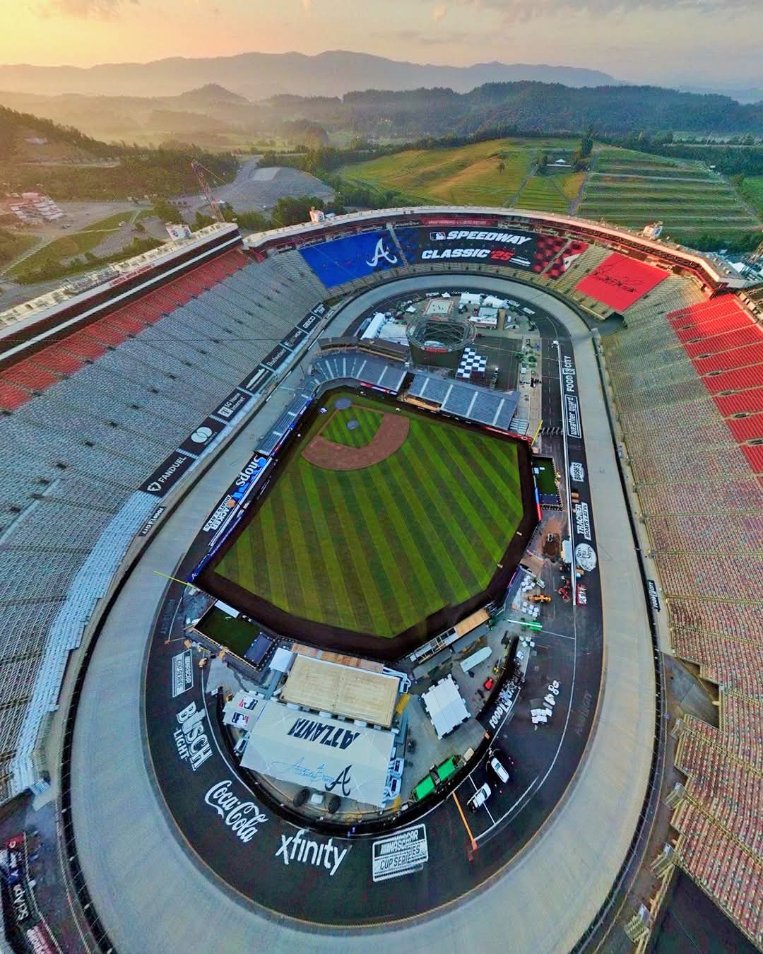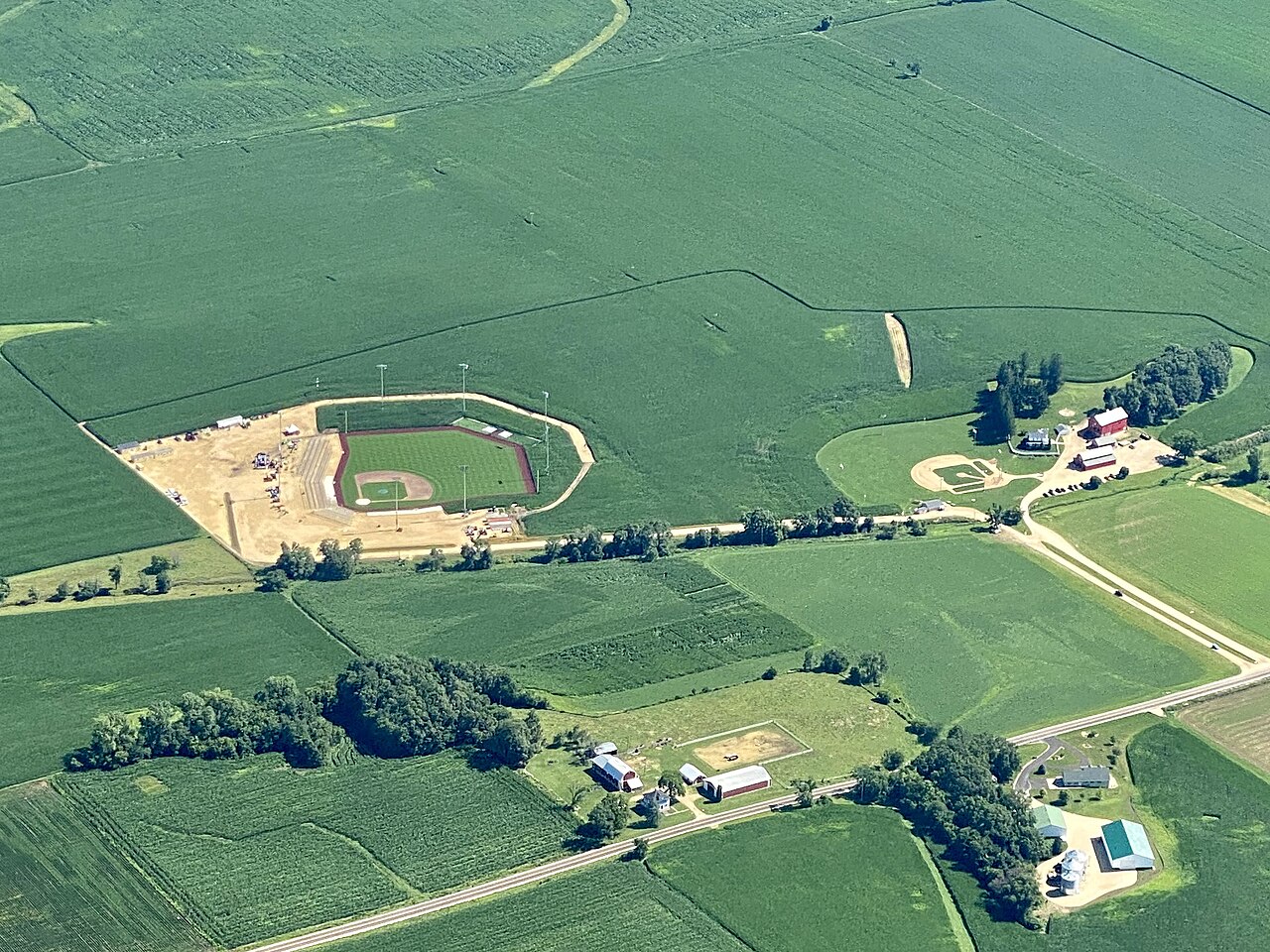With two decades as the city of Salem’s director of civic facilities, current Salem City Councilman John Saunders has seen plenty of growth.
But one night in the 1980s, when Saunders dropped by to visit his good friend and fellow 1978 Salem High School graduate Murray Cook, he witnessed a scene that has remained etched in his mind for 40 years.
“At one time he lived at the Mews. That was the apartment complex,” Saunders recalled. “We went there one night for a get-together, a party, and he had grown grass on the top of a bar … indoors.”
Murray Cook might not be able to grow grass everywhere, but he sure has been trying.
As the president of Sports Turf Division for Brightview, a Pennsylvania-based company that is an industry leader in commercial landscaping, Cook has overseen the construction of baseball fields in more than 60 countries.
Major League Baseball has had Cook on speed dial since the 1990s.
The Salem native and current Roanoke County resident has built ballfields in Australia, Greece, China, England and Japan. He has laid down diamonds in Fort Bragg, North Carolina, and Williamsport, Pennsylvania.
Cook built the first pitcher’s mound ever constructed in Russia.
He was part of a group that helped redesign the National Mall in Washington in advance of the 2012 Presidential Inauguration.
Cook even had the recipe MLB needed to recreate a playing surface in Dyersville, Iowa, on the site where the movie “Field of Dreams” was filmed — corn and all.
Saturday, Cook’s handiwork will be on nationwide display again when an MLB single-game record crowd of more than 85,000 spectators is expected to assemble at Bristol Motor Speedway as the Atlanta Braves and Cincinnati Reds play the first Major League regular-season game ever held in the state of Tennessee.
Welcome to Major League Raceball.
*****
Cook lived in downtown Salem on Colorado Street when he was a young boy before his family moved to Roanoke Boulevard near Municipal Field, now known as Billy Sample Field at Kiwanis Park.
“We lived in the closest house to the ballpark,” he said. “It was kind of in my back yard. A lot of my high school buddies lived down there. The East Bottom Boys they called them.”
Cook’s father worked at Salem’s McVitty Tannery, which the U.S. Environmental Protection Agency later listed as a Superfund Site. Cook’s mother had jobs in the McVitty Home and Tarpley’s Restaurant.
Cook worked too, hustling for foul balls and home runs hit by players on Salem’s Class A Carolina League affiliate of the Pittsburgh Pirates.
“We all worked,” said boyhood friend Hunter Holliday, now a Salem City Councilman. “I had a paper route. He worked at the ballpark.”
Holliday still calls Cook by his given name, Lloyd. “Murray” is merely a nickname that has remained for more than 50 years.
The moniker originated when Cook’s maternal grandfather, John Murray, began taking him to the minor-league ballpark around 1970. “When I was going to the ballpark and they saw my granddad, they said, ‘Look at Little Murray coming up,'” said Cook, now 65. “It just kind of stuck as a nickname.”
The Salem Pirates won the Carolina League championship in 1972, led by the late Baseball Hall of Famer Dave Parker. The club’s assistant director of minor league operations at the time was another Murray Cook, a native of Canada who later became the general manager of three MLB teams, including the New York Yankees.
“People would yell out, ‘There’s two Murray Cooks here!’ It was more of jabbing joke then,” the Salem-bred Cook said. “It’s funny, I’ve known Murray, the other Murray Cook, since the Seventies. Sometimes I’ll get emails for him from his friends. He gets emails for me.”
Cook was 13 when his life took a difficult turn.
“It was a rough time with family,” he said. “I lost my [older] brother, my father, my grandfather, my grandmother. For a teenager, it was kind of tricky. The ballpark was stable. It wasn’t going anywhere.”
The outfield walls of the old stadium offered a warm embrace.
“The ballpark was kind of his way out, keeping him busy,” longtime friend Chad Kropff said.
Cook credits Morris Cregger Sr., and two other 1970s-era Salem businessmen, Ralph Richardson and Homer Clemens, with nudging him in the right direction.
“When you’re at the ballpark you’re a jack-of-all-trades kind of guy: public address, clubhouse duty, cleaning stands, bat boy, ball boy,” Cook recalled. “I pitched batting practice as I got older. Morris took me under his arm.”

Cook attended Andrew Lewis High for three years before the current Salem High School opened in the fall of 1977. Despite never playing high school baseball, he played two seasons of college baseball at North Carolina Wesleyan.
“My shoulder started hurting a little bit so I said I better stop this,” he said.
Cook attended college for just two years. His real education in turf management came from a less formal institution.
“It was the school of hard knocks,” he said. “There was really no way to get an education in doing field work so I kept moving on.”
*****
Cook’s career path began in Salem in the 1980s when he worked at the old ballpark in Salem but also did consulting work at different levels of baseball in Harrisburg, Pennsylvania; Charlotte and Salt Lake City.
“You learn from folks in different worlds,” he said. “But I learned the basics from my friends in Salem. The city of Salem was a big part in my life helping get me where I am today.
“You kept learning more and more as you went along. Materials … people kept seeing that there were better soils, better clays, better products. I started learning more about those items and started exchanging phone calls with friends at Lynchburg and other area ballparks.”
In the late 1980s, he began a seven-year run as the facilities manager at the spring training complex in West Palm Beach, Florida, that jointly housed the Braves and Montreal Expos, earning SportsTURF Man of the Year honors in 1991.
Cook was hired as the athletic field turf consultant at Disney’s Wide World of Sports Complex in Bay Lake, Florida, overseeing a 10-field complex near Orlando.
In 2000, Cook joined BrightView as the president of its Sport Division, which includes 70 golf courses.
When Cook tees up a job, it usually involves a baseball field.
Most notably, the Salem native has built facilities for the 2004 Summer Olympics in Athens, the 2008 Summer Games in Beijing, the MLB regular-season game in 2014 between the Los Angeles Dodgers and Arizona Diamondbacks at the Sydney Cricket Grounds in Australia, the MLB games in conjunction with the Little League World Series in Williamsport, Pennsylvania, as well as MLB games in Tokyo and London.
“The draw is going to places where you can take the game to people who’ve never been to one,” he said. “That makes it more difficult, but it also makes it fun. You’re educating, teaching and helping people understand something they don’t know.”
Cook also helped build a stadium for a July 3, 2016, game between the Braves and Miami Marlins at Fort Bragg, North Carolina, the first MLB game ever held on an active U.S. Military base.
Cook said when Rob Manfred became Commissioner of Baseball in 2015, the powder keg exploded.
“After we took a game to Australia we were like, ‘Wow,’ we just did this in 18 days,” Cook said. “We just built an awesome venue in another country. Commissioner Manfred came on board the next year and he was like, ‘Go!’
“He was already looking at playing at the Field of Dreams. I brought up Fort Bragg. He was already looking at Williamsport. It just started snowballing.”
The aggressive push led to Cook’s most famous and perhaps most endearing work, constructing the stadium adjacent to the “Field of Dreams” site in Iowa in 2021, where the Chicago White Sox played the Yankees, followed by the Chicago Cubs vs. the Reds in 2022.
Remember Kevin Costner leading the White Sox and Yankees onto the field through the corn? Cook had to grow it.
“We created corn and grew corn in order for the players to come through the corn and walk through the right-field fence,” Cook said. “Creating those rows and the fencing system to ensure that did not look like a fence, we designed a fencing system with no [visible] posts. We offset the posts into the corn by about 2 feet. So the corn grew up around it and you couldn’t see the posts.
“I learned more about corn than I really want to know … all the science behind corn. It’s pretty big stuff in Iowa, obviously. Understanding the whole ‘knee high by July’ thing had some merit to it. We had to irrigate the corn. We had to have that corn to a certain height in August or it wouldn’t have been great.”
Cook said consideration was given to building the field on the exact spot where the iconic 1989 baseball movie, starring Costner, Ray Liotta, Burt Lancaster, James Earl Jones and Amy Madigan was filmed. Ultimately, the movie field was left to the ghosts of Shoeless Joe Jackson and Smoky Joe Wood, and MLB built its stadium on nearby ground.
“We looked at the movie field as a site, but what we built around it would have just totally ruined the great feeling about that site,” he said. “We moved home plate to the west, one thousand feet.
“So we had the vista of the house and the movie field over the right-field wall. So if you’re in the seating bowl, you could see the lights, the [movie] field lit up over there. When I went out there I had goosebumps.”
*****
The folks at Bristol Motor Speedway are nothing if not innovative.
The track hosted a college football game between Tennessee and Virginia Tech in 2016 that drew an NCAA-record 156,990 spectators.
In 2021, NASCAR converted the World’s Fastest Half-Mile track from a concrete to a dirt surface for three Cup races, ending in 2023.
Meanwhile, Manfred wasn’t letting any grass grow under his feet in exploring potential venues, so in 2017, he approached Cook and MLB Chief Operations and Strategy Officer Chris Marinak.
“When this thing came about as an idea, that’s something the commissioner challenged myself and Chris Marinak to take a look at where else could we go play,” Cook said.
“I was toying around with ‘Hey, how about the speedway?’ He mentioned Bristol. I looked at Google Earth and said, ‘Yeah, that could work. It just checked the box. They haven’t played in Tennessee before, and just the size of the infield being open gave us a good base to work with. Let’s put this in the “maybe” pile.’ Now we’re here.”
Cook has been in Bristol since June 22, overseeing the installation of the synthetic turf that will be used by the two National League teams. 
Two other companies, an architectural firm and another group in charge of construction of the temporary bowl of 3,000 seats closest to the field, are also on the job.
While the baseball field and the stage for Saturday’s pregame concert featuring Tim McGraw and Pitbull have fit snugly inside the 36-degree banking of the racing surface, installation has not been without a challenge.
Part of the pit road wall and a portion of the Goodyear building in the track’s infield have been removed. The field had to be positioned so that the four-sided racing scoreboard tower known as “Colossus” is just outside the left-field foul pole.
After FOX and MLB did their initial site review, approximately 200 extra lights were added to the facility to bring the level up to standard for the 7 p.m. game.
“Other than that, it’s a big build,” Cook said. “It’s four times what we do in London as far as the amount of materials we’re using. It’s a lot of moving parts. We’re doing not only the field, we’re doing the fencing, the batter’s eye, the backstop, the dugouts, the lights. We’re touching all that.”
Filling and leveling the inside of the track required 17,000 tons of gravel, with the base at a depth of 4 feet in the lowest-lying area.
His crew includes approximately 40 people: a field crew, a local crew, subcontractors, a synthetic turf team, an irrigation turf team, and a local contractor.
Wednesday, as the final touches were applied in preparation for Baseball Hall of Famers Johnny Bench and Chipper Jones to throw the ceremonial first pitch, Cook was training students from nearby East Tennessee State University to serve as the tarp crew on Saturday.
Cook has managed another successful build.
Just what is the secret sauce?
Kropff, his old boyhood friend who followed Cook throughout the Southeast United States for years and now runs his own successful sports field management business in Pittsylvania County, offered a hint.
“People will do whatever it takes to get the job done for him,” Kropff said. “He doesn’t force it on you. He’s chosen his crew with him along the way. He’s probably got the best of the best crew working with him. Kevin Moses and Chad Olsen are probably two of the best guys in the industry, and he can rely on those two guys. He can do his job, knowing those two guys are standing up and getting things right. He knows what he’s looking for.”
***** 
Cook has worked as a consultant for Major League Baseball in some fashion since 1991.
He also helped the city of Salem and legendary local architect Francis “Doc” Shane design the current Carilion Clinic Field at Salem Memorial Ballpark, which opened in 1995.
“We used him if we had any trouble over at the new ballpark,” Saunders said. “Murray was only a phone call away, and he never sent us a bill. It wasn’t a question of was he going to get paid. We were his hometown ballfield, so he couldn’t let anything fail here.”
Saunders cited a case during the Salem Avalanche’s tenure when the surface at Salem Memorial was hit with an outbreak of Poa trivialis, an invasive grass that gives a yellow, blotchy appearance.
“We had two mowers. One was for the [football] stadium and one was for the baseball stadium,” Saunders recalled. “When the one from the baseball stadium broke down, we took the one from the football stadium over. Well, guess what came with it?
“People would say, what’s wrong with the outfield grass? The Avalanche at the time couldn’t catch a fly ball. We kept saying that’s where the balls always hit and it killed the grass.
“It was all ‘Secret Squirrel’ at that time. He came in for us and took a look at it. We replaced the entire infield and took the old infield to the outfield [spots]. He saved the city a ton of money. We didn’t have that kind of money in the department.”
Cook had a simple explanation for his extraordinary largesse.
“Hometown took care of me during some rough times there, so it was good that I could take care of them,” he said.
The guy who made 25 cents per ball shagging fouls and home runs as a 12-year-old seems to have more than paid his dues. In 2021, the city of Salem issued an official proclamation declaring that every September 27 be “Murray Cook Day.”
“Murray broke ground in a lot of areas in a field where think about it, how many people grow up with the idea of being a groundskeeper?” Saunders said. “And what he took it to? He took it to a completely new level. Just a small country boy, and he’s seen the world. It’s just amazing.”
In April, Cook was one of nine individuals inducted into the Virginia Sports Hall of Fame, along with former Detroit Tigers star Lou Whitaker of Martinsville and former NBA No. 1 draft choice Joe Smith of Norfolk.
Each inductee received a plaque that reads in part, “[for] a lasting contribution to the cause of sports in Virginia, the nation and the entire world.”
Cook fills that bill.
On the road for approximately 150 to 200 days a year, he values his time at home in southwest Roanoke County.
His daughter and son live in Roanoke city. He has sons in Pennsylvania and Washington, D.C. He and his wife have three grandchildren.
Cook even cuts his own grass.
“I’ve got a little mower. When I’m home, I cut the back yard,” said. “I do OK. It’s little bit of a shoemaker’s shoe.”
However, there is always one question the neighbors always have to ask:
“How do you get those lines in the grass, those stripes?”





